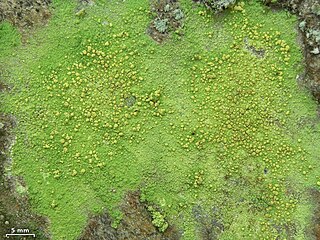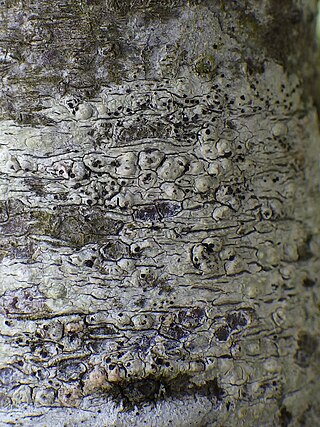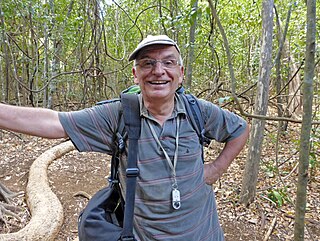Related Research Articles

The Cladoniaceae are a family of lichen-forming fungi in the order Lecanorales. It is one of the largest families of lichen-forming fungi, with about 560 species distributed amongst 17 genera. The reindeer moss and cup lichens (Cladonia) belong to this family. The latter genus, which comprises about 500 species, forms a major part of the diet of large mammals in taiga and tundra ecosystems. Many Cladoniaceae lichens grow on soil, but others can use decaying wood, tree trunks, and, in a few instances, rocks as their substrate. They grow in places with high humidity, and cannot tolerate aridity.

The Arthoniales is the second largest order of mainly crustose lichens, but fruticose lichens are present as well. The order contains around 1500 species, while the largest order with lichenized fungi, the Lecanorales, contains more than 14000 species.

The Roccellaceae are a family of fungi in the order Arthoniomycetes. Most taxa are lichenized with green algae, although some are lichenicolous, growing on other lichens.

Psilolechia is a genus of four species of crustose lichens. It is the only member of Psilolechiaceae, a family that was created in 2014 to contain this genus.

Micarea is a genus of lichenized fungi in the family Pilocarpaceae. The widely distributed genus contains 126 species and new species are described actively. Species in the genus are crustose lichens and their photobiont is a single-celled green alga.
David Leslie Hawksworth is a British mycologist and lichenologist currently with a professorship in the Universidad Complutense de Madrid in Madrid, Spain and also a Scientific Associate of The Natural History Museum in London. In 2002, he was honoured with an Acharius Medal by the International Association for Lichenology. He married Patricia Wiltshire, a leading forensic ecologist and palynologist in 2009. As of 2022, he is the Editor-in-Chief of the journals IMA Fungus and Biodiversity and Conservation.

Skyttea is a genus of lichenicolous (lichen-dwelling) fungi in the family Cordieritidaceae. The genus was circumscribed in 1981 by lichenologists Martha Allen Sherwood, David L. Hawksworth, and Brian J. Coppins, with Skyttea nitschkei assigned as the type species.
Gyalectidium is a genus of lichen-forming fungi in the family Gomphillaceae. A 2020 estimates placed 52 species in the genus. The genus was circumscribed by Swiss lichenologist Johannes Müller Argoviensis in 1881. He included 3 species: G. xantholeucum, G. dispersum, and G. filicinum; the last of these is now the type species of the genus.
Dictyonema is a genus of mainly tropical basidiolichens in the family Hygrophoraceae.
André Aptroot is a Dutch mycologist and lichenologist. His primary research focus is on biodiversity, particularly tropical lichens, encompassing systematics, floristic surveys, and taxonomic reviews. A prolific researcher, he has published more than 500 scientific papers and described hundreds of new fungal and lichen species.
Brian John Coppins is a botanist and lichenologist, considered a world authority on crustose lichens and a leading expert on the genus Micarea.

Emmanuël Sérusiaux is a Belgian lichenologist. His career, spanning more than four decades, has combined both lichenology research and political aspects of nature conservation. He spent several periods working as a researcher at the National Fund for Scientific Research and the University of Liège, the latter in which he accepted a faculty position as professor and head of the Plant Taxonomy and Conservation Biology unit. Sérusiaux also served for three non-consecutive appointments as Deputy Chief of Staff in the Government of Wallonia. He retired from both his academic and political positions in 2019.

Cordieritidaceae is a family of fungi in the order Cyttariales. Species in this family are saprobes or lichenicolous.
Vezdaea is a genus of crustose lichens in the monotypic family Vezdaeaceae, which itself is the only taxon in the order Vezdaeales. The genus was circumscribed by Elisabeth Tschermak-Woess and Josef Poelt in 1976. The genus name honours Czech lichenologist Antonín Vězda (1920-2008).

Halecania is a genus of fungi in the family Leprocaulaceae. It has 22 species. The genus was circumscribed by Austrian lichenologist Michaela Mayrhofer in 1987, with Halecania alpivaga assigned as the type species. She created Halecania to contain species, formerly placed in Lecania, with the following characteristics: uniformly amyloid apical domes, paraphyses with dark brown apical caps, and halonate ascospores.

The following outline provides an overview of and topical guide to lichens.
James Donald Lawrey is a biologist, specialising in lichens. He is known for leading long-term monitoring projects, taxonomy and studies of the evolution of the fungi in lichens.
Alexandra "Sandy" M. Coppins is a Scottish lichenologist. She was president of the British Lichen Society from 2002 to 2004.
Alyxoria viridipruinosa is a species of corticolous (bark-dwelling) and lignicolous (wood-dwelling) lichen in the family Lecanographaceae. It is found in Europe, where it grows on hardwood trees.

Robert Lücking is a German lichenologist, known for his extensive research on foliicolous lichens and his significant contributions to the taxonomy, ecology, and biodiversity of fungi and lichens. He earned his master's and PhD from the University of Ulm, focusing on foliicolous lichens. He has received numerous awards for his work, including the Mason E. Hale Award for his doctoral thesis, the Augustin Pyramus de Candolle prize for his monograph, and the Tuckerman Award twice for his publications in the scientific journal The Bryologist.
References
- 1 2 3 4 "Dr Rebecca Yahr, Lichenologist". Royal Botanic Garden Edinburgh.
- 1 2 3 4 5 6 7 Rushton, Susie (2022). "Rebecca Yahr Lichenology 101". The Gentlewoman. No. 25. Retrieved November 19, 2022.
- ↑ Rushby, Kevin (February 5, 2022). "What to see on a winter walk: an experts' guide to spotting birds, fungi and fossils". the Guardian. Retrieved November 27, 2022.
- ↑ Edinburgh, Royal Botanic Garden. "Lichen conservation leads public on a trail of discovery". www.rbge.org.uk.
- ↑ "The Lichenologist - Editorial board". Cambridge University Press. Retrieved June 28, 2024.
- ↑ "IUCN SSC Lichen Specialist Group". ICUN. Retrieved November 19, 2022.
- ↑ Diederich, Paul; others, and (2012). "New or interesting lichens and lichenicolous fungi from Belgium, Luxembourg and northern France. XIV" (PDF). Bull. Soc. Nat. Luxemb. 113: 95–115.
- ↑ Lendemer, J C; Yahr, R (2004). "Phaeographis illitoraticola Lendemer, R.C.Harris & Yahr". Evansia. 21 (3): 128.
- ↑ "BSA Young Botanist Awards". Botanical Society of America. Retrieved June 28, 2024.
- ↑ Buck, William R.; Sérusiaux, Emmanuël (2000). "Gyalectidium yahriae, sp. nov. (Lichenized Ascomycetes, Gomphillaceae) from Florida and Papua New Guinea" (PDF). The Bryologist. 103 (1): 134–138. doi:10.1639/0007-2745(2000)103[0134:GYSNLA]2.0.CO;2. hdl:2268/175233. S2CID 85995500.
- ↑ "Systematics Association Founders' Lecture 2023". The Systematics Association. Retrieved October 13, 2023.